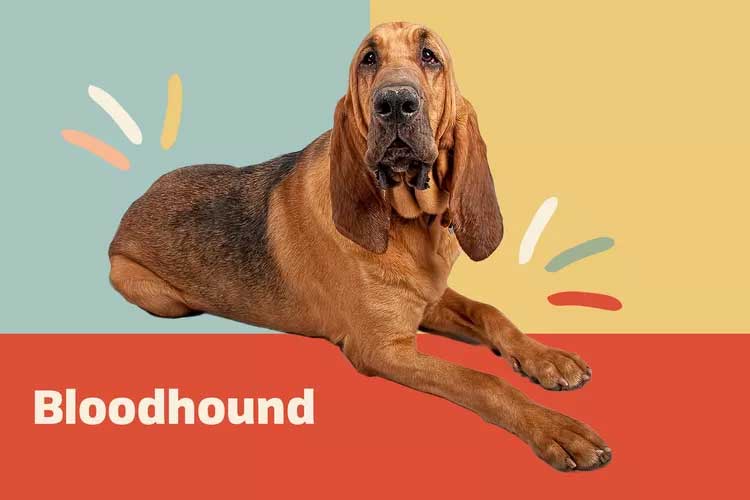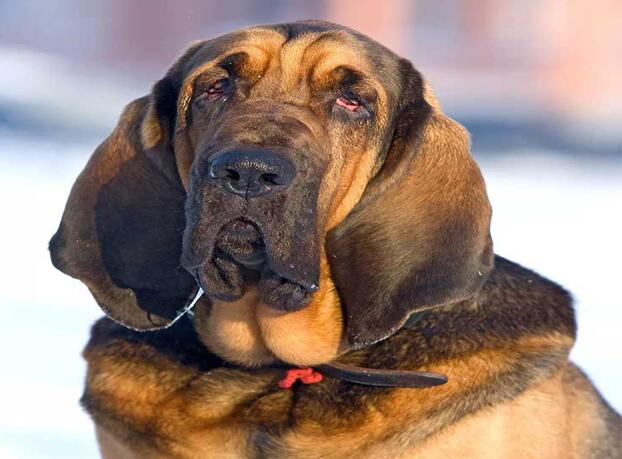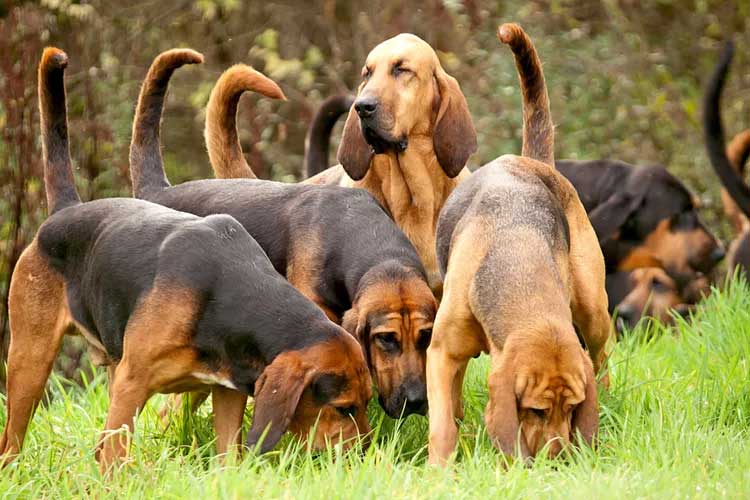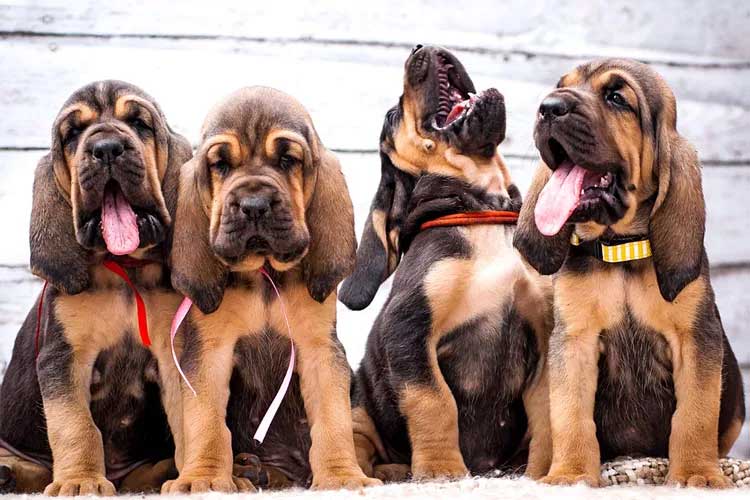Bloodhounds are talented trackers who live by their noses, require dedicated care, and love their humans. Learn more about living with a bloodhound.

Bloodhound Overview
| OFFICIAL NAME | Bloodhound |
| COMMON NAME | Bloodhound |
| PET HEIGHT | 23 to 27 inches |
| PET WEIGHT | 80 to 110 pounds |
| LIFESPAN | 10 to 12 years |
| GOOD WITH | children, dogs, families |
| TEMPERAMENT | friendly, gentle, willful |
| INTELLIGENCE | medium |
| SHEDDING AMOUNT | seasonal |
| EXERCISE NEEDS | medium |
| ENERGY LEVEL | calm |
| VOCAL LEVEL | infrequent |
| DROOL AMOUNT | high |
| BREED GROUP | hound |
| BREED SIZE | large (61-100 lbs.) |
| COAT LENGTH | short |
| COLORS | black, brown / chocolate / liver, fawn, red |
| PATTERNS | bicolor, black and tan, liver and tan |
| OTHER TRAITS | good hiking companion, strong loyalty tendencies, tendency to chew |
Bloodhounds are affable, docile dogs when hanging out at home and eager, dedicated trackers when they're on the scent. There's a reason bloodhounds are famous for detective work—they have a keener sense of smell than any other breed of dog.
Owning a bloodhound takes work. As the American Bloodhound Club puts it, "They are big, powerfully built, slobber, and they eat a lot." But if you're willing to put in the effort, you'll be rewarded with a loyal companion who will make you laugh and love you forever. Mournful eyes, wrinkled faces, and long, droopy ears give bloodhounds the appearance of a sleepy old man, endearing them to generations of dog owners.
Appearance
Bloodhounds are such effective trackers because of their wrinkled skin and long, droopy jowls and ears—all features that help intensify scents, says Landa Coldiron, a bloodhound handler in California who specializes in finding lost pets. Even the breed's signature droopy eyefolds play a part: The skin drops down and covers up their eyes when they have their noses to the ground, allowing them to focus their attention on the scent trail.
Bloodhounds also have incredible endurance; they're able to cover lots of ground for a long time. Male dogs are typically 25–27 inches tall, weighing 90–110 pounds, while female bloodhounds are 23–25 inches tall and weigh 80–100 pounds. Some bloodhounds can get even larger, so be prepared—your little bloodhound puppy is going to get big.
Bloodhounds have eyes that vary in color from deep hazel to yellow, and have a short, dense coat that comes in three standard colors: black and tan, liver and tan, and red.
Not to be confused with a basset hound, bloodhounds are much larger and heavier than their short-legged cousins.
Temperament
Despite the image of the bloodhound lounging sleepily on the porch, this breed is actually quite active. They need plenty of exercise and mental stimulation, which means getting outside and letting him put his nose to good use on long walks and day hikes. Bored bloodhounds (especially puppies) will keep themselves busy by chewing, digging, and destroying furniture.
"There's a thing that's always stated: 'A happy life for a bloodhound is at the end of their nose,'" says Brenda Wendt, professional conservation detection canine trainer and handler. "It just is. That's what they were bred for; that's why they have all those wrinkles. You have to let them use what they were blessed with."
As social animals, bloodhounds get along with other dogs and even cats. They enjoy being with children, though because of their less-than-average eyesight, Wendt says these large dogs can inadvertently knock over or step on very small kiddos and pets. Like with all dogs, kids should be supervised during puppy playtime and be taught how to interact with pets.
"They're gentle giants for sure," Coldiron says.
Bloodhounds don't bark often, tending instead to bay (making a long "rooo" sound) when they smell something interesting.
Just remember that a bloodhound can have a one-track mind. Once he's caught a scent, he's going to be intently focused on that scent—whether it's something in your garbage, a trail leading across the street, or his favorite treats you've tucked away in the pantry.
"You can't hide their food from them," Wendt says. "You can't hide their beloved toys from them. Because they're going to smell it and, if they want to get to it, they can."
Living Needs
If you've ever watched "The Beverly Hillbillies," you're probably familiar with the family's dog Duke, a lazy bloodhound who spent his days lounging around the mansion."So many people have a misconception about the bloodhound," Wendt says. "[The show] made that appearance that they're calm and quiet and they just sleep, [but] no. You must allow them to use that nose and you must allow them to go out and investigate the world with their nose."
Given how large and active bloodhounds are, they do best in a home with a large, fenced-in yard. The fence should be at least 6 feet high and secured underground, because bloodhounds dig—and if they've caught the scent of something interesting, they'll go after it at all costs.
"They're escape artists," Coldiron says. "They have wanderlust for sure." She recommends making sure that your dog is microchipped and has some kind of ID on them.

But just because you have a big fenced space doesn't mean you can just let you bloodhound out to entertain himself, Wendt says.
"They're familiar with their backyard," she says. "They want different smells. So getting them out and going other places, that's the way that you can tire them. "
Bloodhounds love the outdoors and enjoy hikes and splashing in water (though they are generally not built for swimming).
"You have to know what your breed was bred for and what will give them the happiness in their life, and not what, as an owner, you think is adequate," Wendt says. "They're not a dog for a runner, no, because that's not their pace. But if you simply like going out into the woods or on a walking path—fantastic, you've got a good partner at a moderate stride. They have to have that."
Because of their scent drive, it's important to keep your bloodhound on-leash at all times when outdoors. They could otherwise take off after a scent for miles, and Wendt says their recall is "isn't going to be there." Once they're well-exercised and worn out, bloodhounds will be quiet pups who will happily snooze by your feet during movie night.
At home, you'll need to make sure food and garbage are secured and that nothing edible is left on countertops—bloodhounds have a reputation as counter-surfers.
Care
Bloodhounds have a short coat, but they will shed once or twice a year. Weekly brushing will help keep hair off of your furniture, and regular bathing will help cut down on the bloodhound's doggy odor.It's important to wipe their eyes daily with a tissue or cotton pad to prevent crusty buildup and clean out their ears with unscented baby wipes or a liquid ear drying solution. Check the skin folds around his face, too, as water (and kibble bits) can easily get trapped in the folds.

If there's one thing to know about bloodhound care, Wendt says, it's that they drool. A lot. She recommends always having a rag nearby to wipe up the drool that will accumulate.
"If you are persnickety, bloodhounds are not going to be your breed," Wendt says. "They're just not. They drool and when they shake their heads that drool flies everywhere."
Bloodhounds have an independent mind and might not always be the star of the doggy obedience class. However, they are intelligent and can be trained with patience and positive reinforcement.
"You are pretty darn lucky if you can get your bloodhound to sit on command and pretty darn lucky if you can get your bloodhound to [lie] down on command," Wendt says. "Usually, they will 'down' best when they're tired."
They do, however, pick up tracking very easily. In fact, bloodhounds are often used today as search-and-rescue dogs.
Health
Regular grooming is an important part of maintaining your bloodhound's health. Because their skin and ears can easily harbor moisture, it's important to keep an eye out for discoloration, excessive itching, and off-odors in their ears and skin folds—all signs of an ear infection.You might also notice bloodhounds are prone to having red eyes. That's usually because the bloodhound's skin is so droopy, it pulls the eyelids down and either causes the eyelashes to irritate the eye, or pulls the tear ducts away from the eyes. Talk to your vet to discuss your bloodhound's eye condition and determine the best course of action.
Additionally, bloodhounds are also particularly prone to bloat, also called gastric dilation volvulus. GDV is a life-threatening condition that occurs when the dog's stomach becomes stretched and rotated, cutting off blood flow to the organs. It's important for dog owners to learn the symptoms of bloat and to get their dog to the vet immediately if the condition arises.
The American Bloodhound Club also recommends screening your bloodhound puppy for elbow and hip dysplasia, patellar luxation, degenerative myelopathy, and conducting a cardiac exam and eye exam.
History
The third-century Roman scholar Aelian mentions a hound with unparalleled scenting abilities that some historians say was an early bloodhound. This bloodhound-type dog appeared in Europe long before the Crusades, likely brought over from Constantinople, according to the breed club.After that, the bloodhound we know today was carefully developed by high-ranking church officials in the monasteries of Western Europe, which is where the name "bloodhound" comes from; they were dogs of aristocratic blood. Early bloodhounds were bred at the Saint-Hubert monastery in Belgium, which is why the dog is called the chien de Saint-Hubert in French.
It's no accident that Saint Hubert is the patron saint of hunters. Bloodhounds were used to pick up the scent of boars and deer during medieval hunts. They've also been used to track down people since the breed's early days: At times, for dark purposes (such as tracking escaped slaves) and at others, for noble ones (like finding lost children).
The modern bloodhound was recognized by the American Kennel Club in 1885, and is still employed by many police departments and detectives for their scent-tracking superpowers.
Fun Facts
There are many beloved fictional bloodhounds, including Mickey Mouse's dog Pluto, Duke from "The Beverly Hillbillies," and Trusty from Lady and the Tramp.Famous bloodhounds include real-life super sleuth named Nick Carter. Born in 1900, Nick found over 650 people, including one whose trail was 12 days old!
A typical bloodhound's nose is lined with 230 million scent receptors—about 40 times as many as a human has.